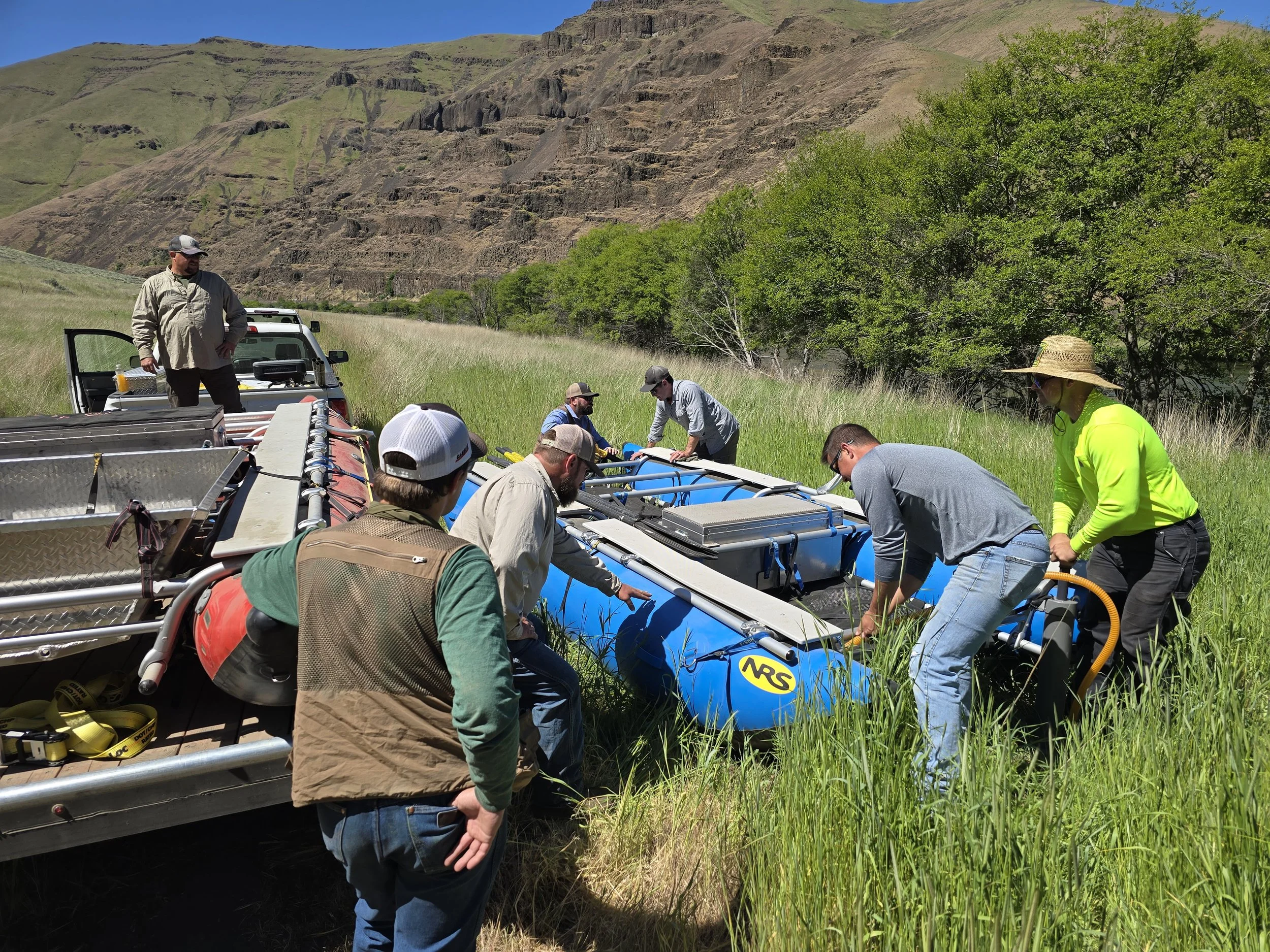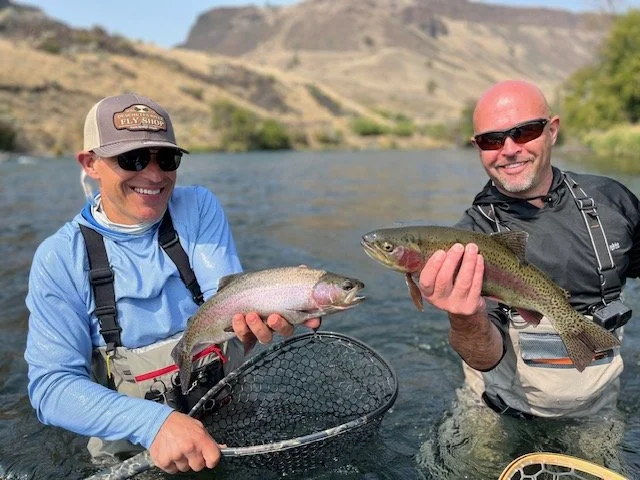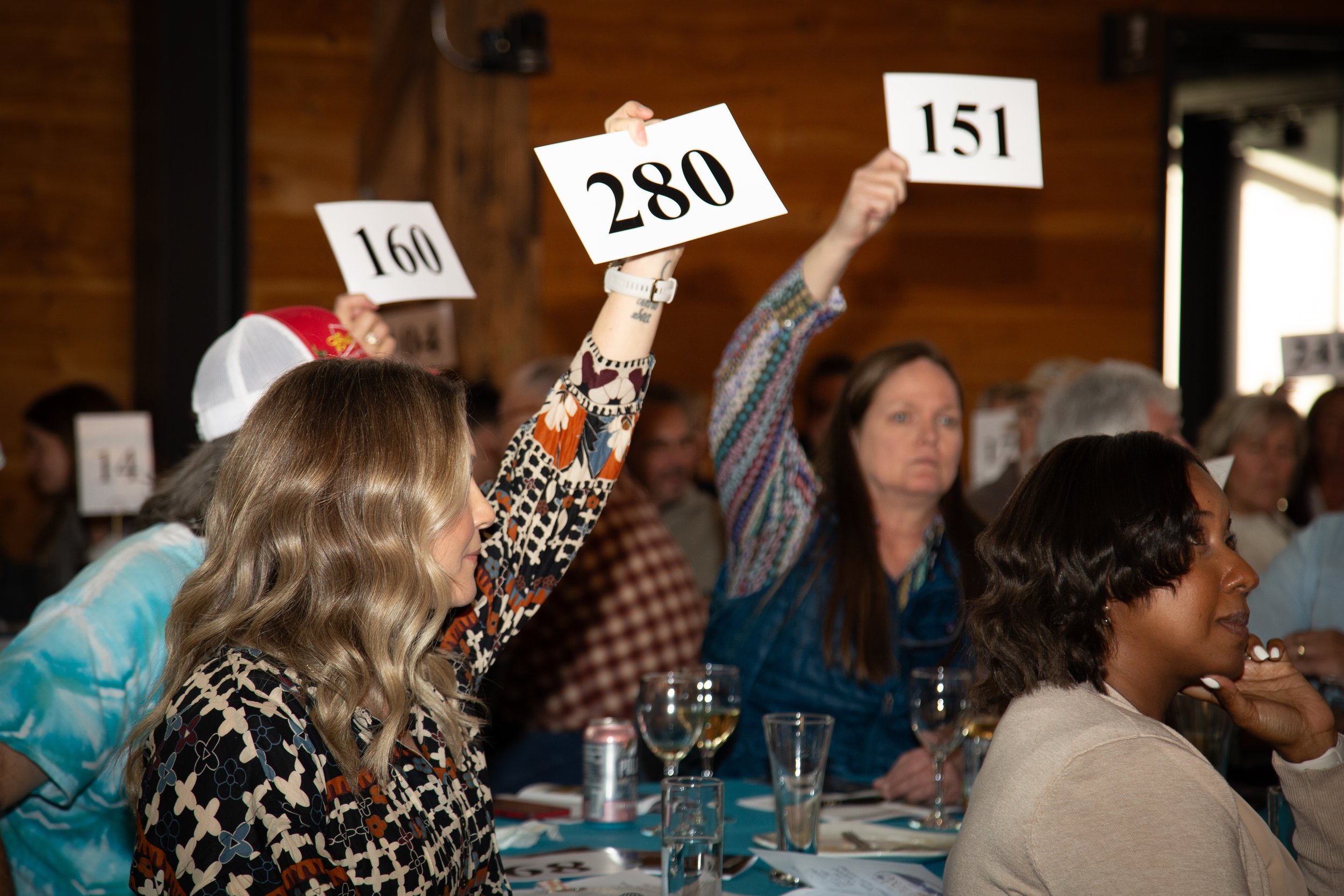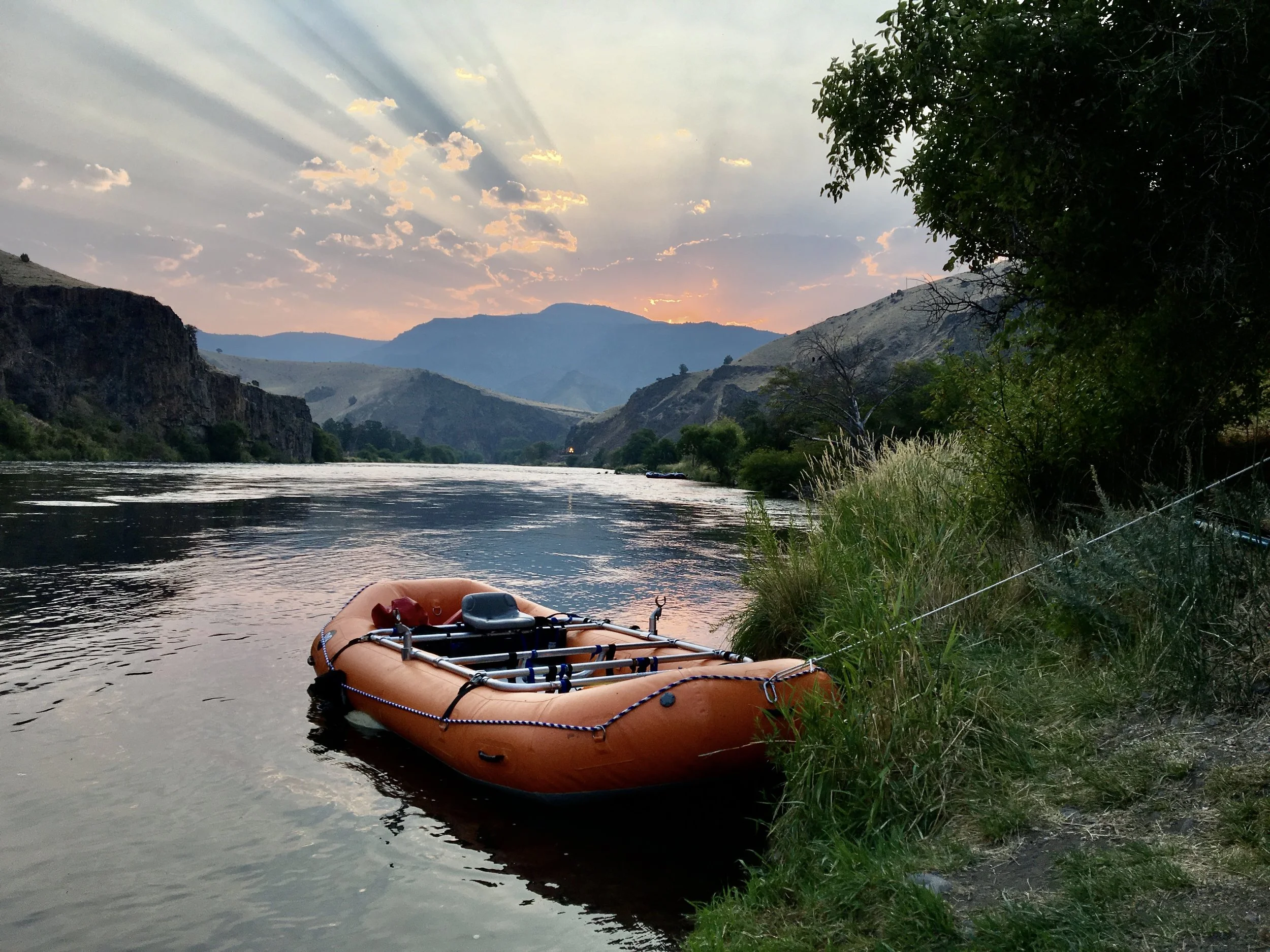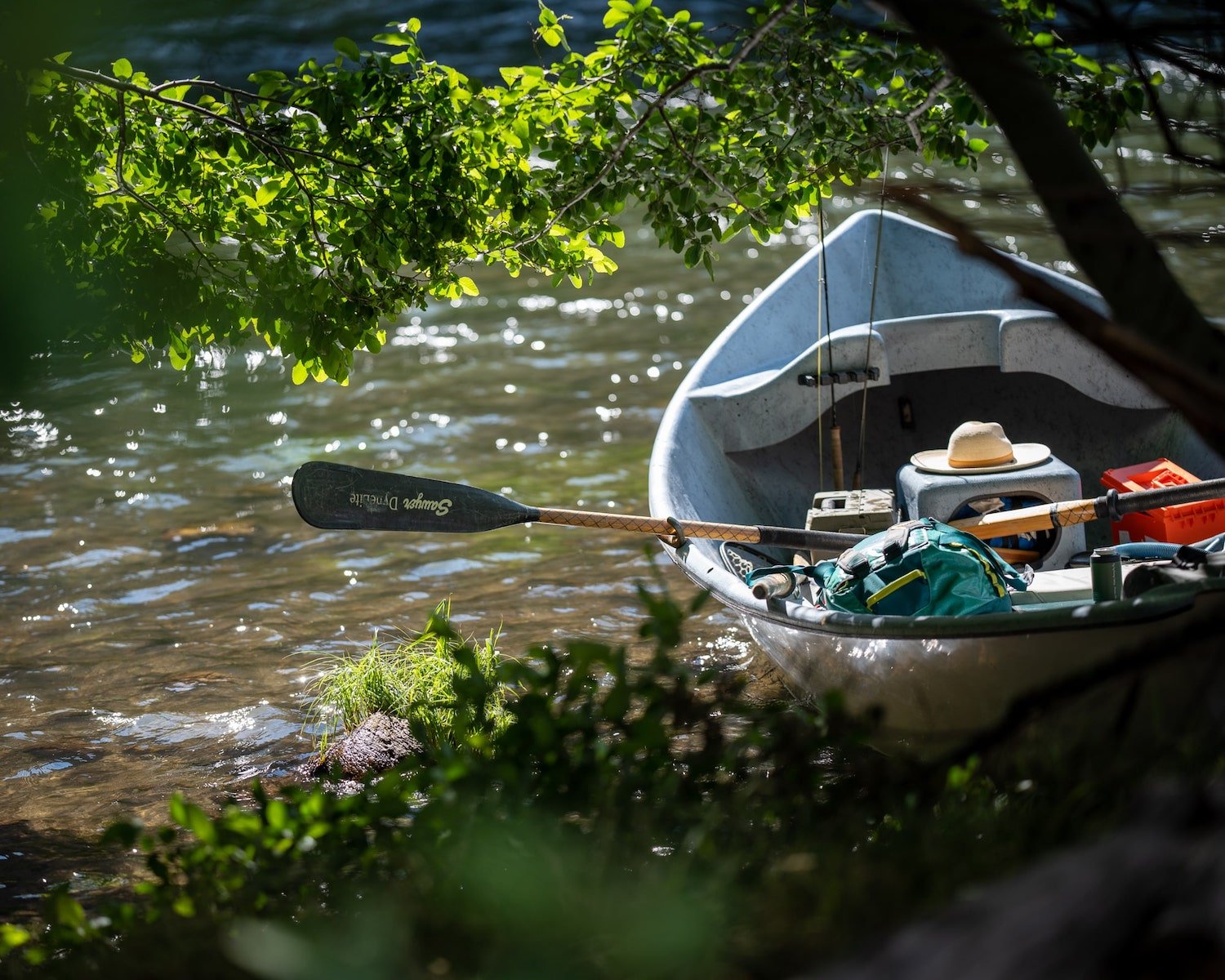Partners in Good Works: Wasco Soil and Water Conservation District
Wasco Soil and Water Conservation District staff and volunteers ready the rubber flotilla for battle against invasive weeds. Photo courtesy of WSWCD.
Making the Happy Place Happier
Rush skeletonweed, crowding river trails like bolted heads of rigid, spiky lettuce from a horror garden. Purple loosestrife, its deceptively pretty flowers choking wet edge habitats. The scourge of leafy spurge, reducing forage for ungulates. Aptly named puncture vine, popping bike tires on the access road. Himalayan blackberry crowding precious desert canyon springs, pinholing waders. Hoary cress and knapweed, outcompeting native grasses and plants. Cheat grass clinging to shoelaces and pantlegs. These invasive weeds are creeping into the lower Deschutes basin like ants at a summer picnic. The picnic ground, in this case covers 83,000 acres known to many Oregonians as their happy place. To Dean Dark, the happy place is also known as the Lower Deschutes Cooperative Weed Management Area (LDCWMA).
Dark is the Wasco County Soil and Water Conservation District’s LDCWMA Coordinator. He is the only full-time person in charge of keeping some semblance of the native plant community intact on the lower Deschutes. He’ll tell you it’s not about the weeds. It’s ultimately about the water, the wildlife, and the native grasses, shrubs and trees that over thousands of years, helped the Deschutes evolve into that happy place. These invasive plants, says Dark, make not only human visitors, but full-time non-human residents of the canyon less happy. “Wildlife suffer,” says Dark. “Streams get choked in. Cheat grass and blackberry prevent cool water from reaching the river.”
Rush skeletonweed (Chondrilla juncea), one of the troublesome weeds on the lower river.
Fire Speeds Invasive Weed Incursion
The Substation Fire of 2018 accelerated the already brisk pace of invasive plant incursion. “From Mack’s Canyon on down, we see a lot of cheat grass that’s taken over. Almost every spring that got burned has been overtaken by blackberry too,” says Dark. Above Mack’s, where the fire damage was less severe, there’s less of a problem. “More of the alder, bitterbrush and sage survived south of Mack’s,” says Dean.
To mitigate the weed problem in the canyon, Dark has cobbled together paid crews capable of strapping on a 40lb backpack and hiking through challenging terrain to spot spray problem plants. A lapse in federal funding this year has made that approach more challenging.
Dark says the river-using public at-large can help. A few minutes of visual training allows campers, boaters, hikers and bikers to spot several species of invaders. Recording their location with your phone and reporting to Dark’s email helps. He’s also looking for ways to make it easier to report. “I’m going to get QR codes to use with the inaturalist app,” says Dark. He’s also looking for volunteers, to head downriver on invasive weed search-and-destroy missions, in part to help mitigate the reduction in funding for summertime crews. “We do a couple float trips a year,” says Dean. “Come along, we’ll explore the Wasco County side of the river.”
Strong Partnerships for a Healthier Lower Deschutes
Dark’s work is part of the larger mission of the WSWCD. Soil and water conservation districts emerged from the disaster of the Dust Bowl droughts of the 1930’s. The vasculature of myriad ecotones across the continent gives districts differing priorities. In Wasco County, the priority is water. “Water quantity and quality remain top priorities for the District,” reads one prominent line from a recent annual report.
Soil and Water Districts, though underheralded, may be land management agencies’ best foot forward in terms of managing whole ecosystems–truly encompassing the whole biotic enchilada–people, water, land, flora native and invasive and fauna wild and domestic. WSWCD accomplishes this mission in part by partnering with a host of different entities: five Watershed Councils, the Forest Service, The B.L.M., the Oregon Water Enhancement Board, The U.S. Fish and Wildlife Service, the Bonneville Power Administration, and individual landowners. That list is not exhaustive.
Abbie Forrest is the Grants and Program Manager for WSWCD. “Our management area is ridgetop to ridgetop, says Forrest. “Our goal is to get people to the table. She says that in addition to invasive weed mitigation, the District does fuels reduction, re-seeding, riparian exclusion (keeping domestic grazers off stream banks) and some stream enhancement and restoration. The District also has an education and outreach program that teaches Wasco County kids some of the finer points in the local landscape that they might grow to appreciate.
“We’ve been really successful in getting strong partnerships,” says Forrest. “We’re seen by other agencies as being able to cut through some of the red tape. So for instance if the Forest Service needs a helicopter to drop logs into a stream, we’re seen as the partner who can make that happen.”
Another line from a WSWCD publication seems to aptly sum up the esprit d’corps of this agency: “we are doers, fixers and partners who show up for the land, the people who steward it, and each other.”
The work is done for the water, too.
More From The Blog
Subscribe the the DRA Newsletter
The Deschutes River Alliance is your focused voice to protect the lower Deschutes River, its cold water flows and the fish and wildlife that are sustained by them. We send regular emails with important data and news about the lower Deschutes River. We will not sell your contact information to others.
How to Support the DRA
Everyone wants clean, healthy water in the Deschutes River. Oregonians cherish our clean and healthy waterways to provide drinking water, wildlife habitat and recreational activities. The lower Deschutes River is a federally designated Wild & Scenic River, and a national treasure. It must be protected for the environmental and economic health of Central Oregon. By working together we can return the lower Deschutes River to full health.

